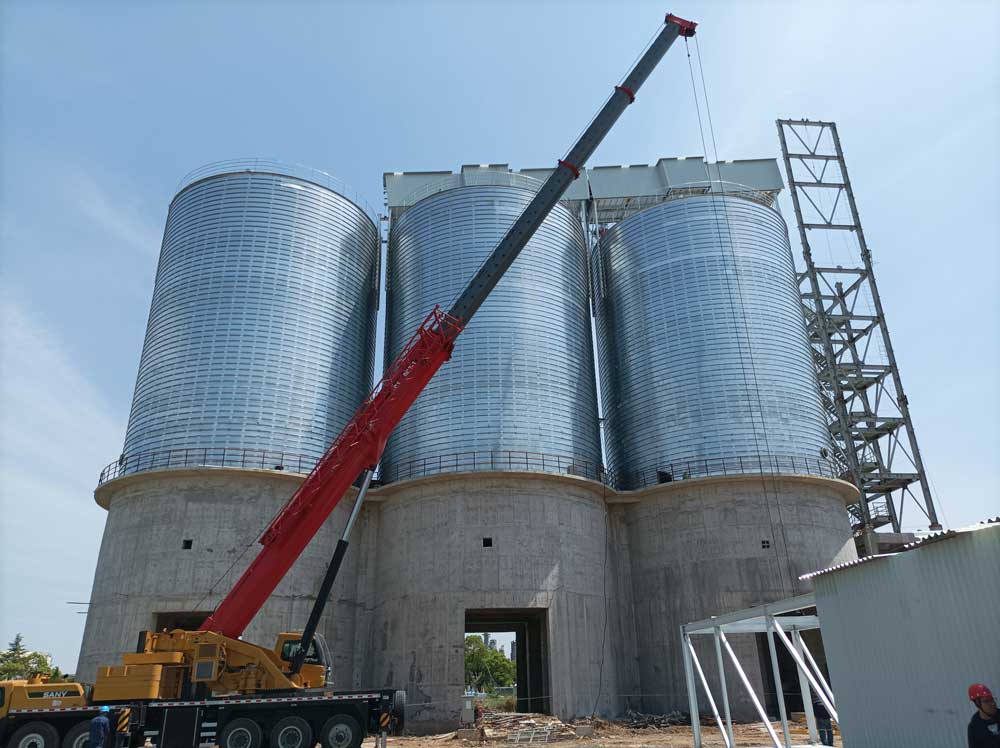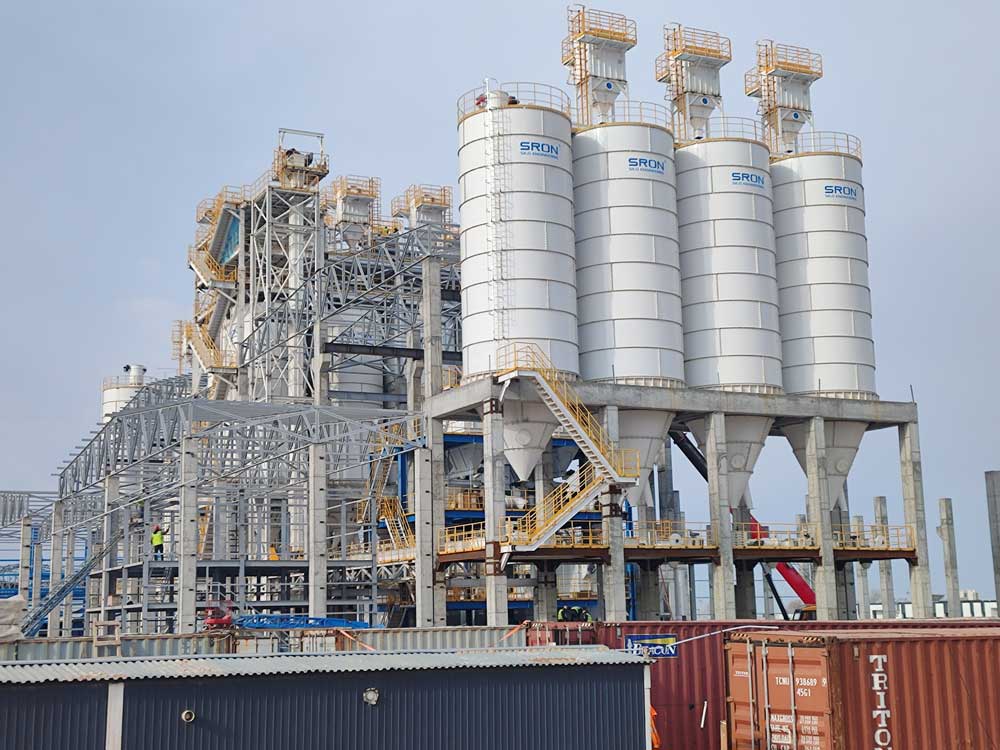In modern industry and the building materials sector, storage systems are an essential component of production. This is especially true for the storage of bulk materials like cement, fly ash, and grain. Choosing the right silo structure not only impacts storage safety and service life, but also directly influences project costs and construction schedules. Currently, the most common storage structures on the market include spiral silos, welded silos, and prefabricated cement silos. Each of these three types offers unique structural characteristics and application advantages.
Spiral Rolled Edge Silos – Fast Construction and Highly Sealed Steel Silos
A spiral rolled edge silo is a silo structure constructed by crimping the edges of steel plates in multiple layers (usually five layers) using on-site construction equipment to form a circular reinforcement structure. This structure combines lightweight construction with high sealing performance and is widely used for storing grain, powders, and liquids.
1. Structure and Principle
The walls of a spiral rolled edge silo are typically flat plates, with five layers of crimping forming circular reinforcement, which is then supported by internal and external columns. Using spiral winding construction technology, the entire silo can be constructed in a short period of time. Wall thicknesses generally range from 2.0mm to 6.0mm, making it suitable for small and medium-sized silo structures.
2. Applicable Materials
This silo type can be used to store a variety of materials, including:
Grains (such as wheat, corn, and rice);
Industrial powders (such as cement, fly ash, and mineral powder);
Sand and gravel aggregates, clinker, and other materials;
Liquid materials (requires a sealing and anti-seepage system);
3. Advantages
Short Construction Period: Spiral rolled edge silos can be quickly constructed on-site, significantly shortening construction time. Lightweight: The overall structure is lightweight, resulting in low construction costs.
Low Transportation Costs: The side panels of spiral hemming silos are shipped as rolled galvanized steel sheets, saving space and reducing shipping costs.
Excellent Sealing: The five-layer undercut technology provides excellent airtightness and watertightness, making it suitable for use in liquid or high-dust environments.
Clean Appearance: The silo's sleek lines facilitate external corrosion protection and insulation.
4. Disadvantages and Limitations
Specialized hemming equipment and an experienced construction team are required. For small-scale projects, equipment transportation and labor costs can be high. Due to the limitations of hemming equipment, spiral hemming silos can only be used for galvanized steel sheets with a thickness of less than 6mm. Therefore, hemming silo capacities typically do not exceed 15,000 tons.
In summary, spiral hemming silos are ideal for projects with high construction time and tight sealing requirements but medium storage capacity, such as powder transfer silos or temporary storage silos.
Welded Silos – High-Strength Steel Silos with Extra-Large Storage Capacity
Welded silos are a type of storage silo constructed from flat steel plates, welded on-site to form a fully enclosed structure. They are widely used in industries such as cement, building materials, and chemicals, and are particularly suitable for large-scale, permanent storage.
1. Structural Features
Welded silos typically feature flat panels with circumferential and vertical reinforcements, resulting in extremely high silo strength. The roof is typically constructed with a truss structure, though grid structures are often used for larger diameters or when heavy loads are required. Wall thicknesses range from 6mm to 25mm and can be customized based on silo capacity and material characteristics.
2. Applications
Welded silos are suitable for the long-term storage of a variety of powders, granules, and solid materials, such as:
cement, clinker, mineral powder fly ash, lime powder flour, grain, and other powdery and granular materials.
3. Advantages
Flexible Storage Capacity: Diameter and height can be freely designed to meet specific needs, allowing single silos to hold capacities ranging from thousands to tens of thousands of tons.
Excellent Sealing: The integrally welded structure eliminates leaks, making it suitable for fine powders and materials with high sealing requirements. Stable structure: Strong wind and earthquake resistance, long service life, suitable for fixed factory storage.
4. Shortcomings and Improvements
The main shortcomings of welding silos are:
The heavy weight leads to high transportation and lifting costs. The long construction period and the large amount of on-site welding require high welder skills. Construction quality is affected by human factors.
To this end, Shirong Company developed an intelligent robotic welding system in 2021, which has been tested and applied in multiple domestic construction projects. Robotic welding technology can significantly reduce labor and construction costs, minimize human errors, maintain stable welding quality, and shorten the overall construction period. This innovative technology marks the beginning of an era of automation and high precision for welding silos.
Prefabricated Cement Silos – Efficient Assembly and Detachable Steel Silos
Prefabricated cement silos are a new type of silo structure that has rapidly developed in recent years. Their fully bolted connection design has become a hallmark of green construction. This structure has demonstrated excellent performance in the industrial sector, particularly in the storage of materials such as cement, fly ash, and mineral powder.
1. Structural Features
Prefabricated silos utilize a combination of flat wall panels, annular flanges, vertical connecting plates, and vertical columns. The wall panels typically range in thickness from 6mm to 25mm, and are assembled entirely with bolts, eliminating the need for on-site welding. Depending on the application industry and material, Shirong's prefabricated steel silos include sheet-type prefabricated steel silos and galvanized corrugated steel silos. Sheet-type prefabricated silos are generally used for bulk building materials such as cement and fly ash, while galvanized corrugated steel silos are used for grain storage.
2. Advantages and Features
Fully prefabricated structure: Easy construction, short construction time, and unaffected by weather.
High Strength and Reliability: The silo boasts a strong integrity, with performance comparable to large welded silos. Reusable: Disassembled and removable, embracing green and energy-saving concepts.
Widely applicable: Suitable for use in everything from medium-sized cement plants to large material transfer stations.
3. Disadvantages and Limitations
The short segment length (approximately 3 meters per segment) and the large number of nodes increase installation workload. The silo is also heavier, and the material cost is slightly higher than that of a roll-edge silo. Prefabricated cement silos, with their modular and recyclable features, are becoming a popular choice among construction companies. They are particularly suitable for small and medium-sized storage projects, those requiring rapid construction, temporary storage, or future relocation.
Recommendations for Choosing Three Silo Types
In actual projects, the choice of silo type should be based on a comprehensive consideration of material type, project scale, construction period, budget, and service life:
If you require quick construction, high sealing performance, and reasonable cost, spiral-wound silos are recommended.
If the project requires large silo capacity, long-term use, and high structural strength, welded silos are recommended.
If you require a disassembly, relocation, environmental friendliness, and a short construction period, prefabricated cement silos are more advantageous.
Different silo types are not mutually exclusive; rather, they offer high-quality solutions tailored to specific needs.
With the advancement of industrialization and intelligent manufacturing, the structural design of storage silos is constantly being optimized. From the efficient sealing of spiral-rimmed silos, to the high strength of welded silos, to the environmentally friendly assembly of prefabricated cement silos, each technological advancement reflects the industry's progress toward higher standards and greater intelligence. In the future, the integrated application of automated welding, modular design, and digital monitoring will make storage systems more efficient, safe, and sustainable, providing superior solutions for the storage of building materials and industrial materials.


.jpg)

.jpg)